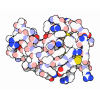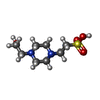[English] 日本語
 Yorodumi
Yorodumi- PDB-4grv: The crystal structure of the neurotensin receptor NTS1 in complex... -
+ Open data
Open data
- Basic information
Basic information
| Entry | Database: PDB / ID: 4grv | ||||||
|---|---|---|---|---|---|---|---|
| Title | The crystal structure of the neurotensin receptor NTS1 in complex with neurotensin (8-13) | ||||||
 Components Components |
| ||||||
 Keywords Keywords |  SIGNALING PROTEIN/AGONIST / SIGNALING PROTEIN/AGONIST /  G-protein coupled receptor / G-protein coupled receptor /  neurotensin receptor / neurotensin receptor /  G-protein / G-protein /  SIGNALING PROTEIN-AGONIST complex SIGNALING PROTEIN-AGONIST complex | ||||||
| Function / homology |  Function and homology information Function and homology informationresponse to antipsychotic drug / Peptide ligand-binding receptors /  neuropeptide receptor binding / G protein-coupled neurotensin receptor activity / inositol phosphate catabolic process / positive regulation of inhibitory postsynaptic potential / symmetric synapse / response to mineralocorticoid / D-aspartate import across plasma membrane / positive regulation of gamma-aminobutyric acid secretion ...response to antipsychotic drug / Peptide ligand-binding receptors / neuropeptide receptor binding / G protein-coupled neurotensin receptor activity / inositol phosphate catabolic process / positive regulation of inhibitory postsynaptic potential / symmetric synapse / response to mineralocorticoid / D-aspartate import across plasma membrane / positive regulation of gamma-aminobutyric acid secretion ...response to antipsychotic drug / Peptide ligand-binding receptors /  neuropeptide receptor binding / G protein-coupled neurotensin receptor activity / inositol phosphate catabolic process / positive regulation of inhibitory postsynaptic potential / symmetric synapse / response to mineralocorticoid / D-aspartate import across plasma membrane / positive regulation of gamma-aminobutyric acid secretion / L-glutamate import across plasma membrane / positive regulation of arachidonic acid secretion / neuron spine / regulation of respiratory gaseous exchange / neuropeptide hormone activity / digestive tract development / negative regulation of systemic arterial blood pressure / hyperosmotic response / negative regulation of release of sequestered calcium ion into cytosol / G alpha (q) signalling events / positive regulation of glutamate secretion / positive regulation of inositol phosphate biosynthetic process / neuropeptide receptor binding / G protein-coupled neurotensin receptor activity / inositol phosphate catabolic process / positive regulation of inhibitory postsynaptic potential / symmetric synapse / response to mineralocorticoid / D-aspartate import across plasma membrane / positive regulation of gamma-aminobutyric acid secretion / L-glutamate import across plasma membrane / positive regulation of arachidonic acid secretion / neuron spine / regulation of respiratory gaseous exchange / neuropeptide hormone activity / digestive tract development / negative regulation of systemic arterial blood pressure / hyperosmotic response / negative regulation of release of sequestered calcium ion into cytosol / G alpha (q) signalling events / positive regulation of glutamate secretion / positive regulation of inositol phosphate biosynthetic process /  temperature homeostasis / response to corticosterone / response to lipid / temperature homeostasis / response to corticosterone / response to lipid /  regulation of membrane depolarization / cellular response to lithium ion / detection of temperature stimulus involved in sensory perception of pain / neuropeptide signaling pathway / response to axon injury / axon terminus / regulation of membrane depolarization / cellular response to lithium ion / detection of temperature stimulus involved in sensory perception of pain / neuropeptide signaling pathway / response to axon injury / axon terminus /  transport vesicle / viral release from host cell by cytolysis / response to amphetamine / blood vessel diameter maintenance / cellular response to dexamethasone stimulus / adult locomotory behavior / peptidoglycan catabolic process / cellular response to nerve growth factor stimulus / positive regulation of release of sequestered calcium ion into cytosol / response to cocaine / dendritic shaft / liver development / transport vesicle / viral release from host cell by cytolysis / response to amphetamine / blood vessel diameter maintenance / cellular response to dexamethasone stimulus / adult locomotory behavior / peptidoglycan catabolic process / cellular response to nerve growth factor stimulus / positive regulation of release of sequestered calcium ion into cytosol / response to cocaine / dendritic shaft / liver development /  learning / learning /  visual learning / visual learning /  terminal bouton / cytoplasmic side of plasma membrane / cell wall macromolecule catabolic process / response to estradiol / terminal bouton / cytoplasmic side of plasma membrane / cell wall macromolecule catabolic process / response to estradiol /  lysozyme / lysozyme /  lysozyme activity / lysozyme activity /  perikaryon / host cell cytoplasm / perikaryon / host cell cytoplasm /  dendritic spine / dendritic spine /  receptor ligand activity / positive regulation of phosphatidylinositol 3-kinase/protein kinase B signal transduction / defense response to bacterium / positive regulation of apoptotic process / receptor ligand activity / positive regulation of phosphatidylinositol 3-kinase/protein kinase B signal transduction / defense response to bacterium / positive regulation of apoptotic process /  membrane raft / membrane raft /  axon / negative regulation of gene expression / axon / negative regulation of gene expression /  dendrite / neuronal cell body / protein-containing complex binding / positive regulation of gene expression / negative regulation of apoptotic process / dendrite / neuronal cell body / protein-containing complex binding / positive regulation of gene expression / negative regulation of apoptotic process /  cell surface / extracellular region / identical protein binding / cell surface / extracellular region / identical protein binding /  plasma membrane plasma membraneSimilarity search - Function | ||||||
| Biological species |   Rattus norvegicus (Norway rat) Rattus norvegicus (Norway rat)  Enterobacteria phage T4 (virus) Enterobacteria phage T4 (virus) | ||||||
| Method |  X-RAY DIFFRACTION / X-RAY DIFFRACTION /  SYNCHROTRON / SYNCHROTRON /  MOLECULAR REPLACEMENT / Resolution: 2.802 Å MOLECULAR REPLACEMENT / Resolution: 2.802 Å | ||||||
 Authors Authors | Noinaj, N. / White, J.F. / Shibata, Y. / Love, J. / Kloss, B. / Xu, F. / Gvozdenovic-Jeremic, J. / Shah, P. / Shiloach, J. / Tate, C.G. / Grisshammer, R. | ||||||
 Citation Citation |  Journal: Nature / Year: 2012 Journal: Nature / Year: 2012Title: Structure of the agonist-bound neurotensin receptor. Authors: White, J.F. / Noinaj, N. / Shibata, Y. / Love, J. / Kloss, B. / Xu, F. / Gvozdenovic-Jeremic, J. / Shah, P. / Shiloach, J. / Tate, C.G. / Grisshammer, R. | ||||||
| History |
| ||||||
| Remark 999 | CHAIN A IS AN INTERNAL FUSION OF LYSOZYME (RESIDUES 2-161 OF UNP P00720) BETWEEN RESIDUES 52-268 ...CHAIN A IS AN INTERNAL FUSION OF LYSOZYME (RESIDUES 2-161 OF UNP P00720) BETWEEN RESIDUES 52-268 AND RESIDUES 300-379 OF Neurotensin receptor type 1 (UNP P20789). AN OFFSET OF 1000 HAS BEEN ADDED TO LYSOZYME RESIDUE NUMBERS WITHIN THE COORDINATES TO DISTINGUISH THAT PORTION OF CHAIN A. LYSOZYME RESIDUES ARE THEREFORE NUMBERED 1002-1161. |
- Structure visualization
Structure visualization
| Structure viewer | Molecule:  Molmil Molmil Jmol/JSmol Jmol/JSmol |
|---|
- Downloads & links
Downloads & links
- Download
Download
| PDBx/mmCIF format |  4grv.cif.gz 4grv.cif.gz | 107.4 KB | Display |  PDBx/mmCIF format PDBx/mmCIF format |
|---|---|---|---|---|
| PDB format |  pdb4grv.ent.gz pdb4grv.ent.gz | 79.5 KB | Display |  PDB format PDB format |
| PDBx/mmJSON format |  4grv.json.gz 4grv.json.gz | Tree view |  PDBx/mmJSON format PDBx/mmJSON format | |
| Others |  Other downloads Other downloads |
-Validation report
| Arichive directory |  https://data.pdbj.org/pub/pdb/validation_reports/gr/4grv https://data.pdbj.org/pub/pdb/validation_reports/gr/4grv ftp://data.pdbj.org/pub/pdb/validation_reports/gr/4grv ftp://data.pdbj.org/pub/pdb/validation_reports/gr/4grv | HTTPS FTP |
|---|
-Related structure data
| Related structure data | 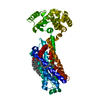 3ny9S S: Starting model for refinement |
|---|---|
| Similar structure data |
- Links
Links
- Assembly
Assembly
| Deposited unit | 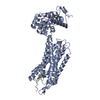
| ||||||||
|---|---|---|---|---|---|---|---|---|---|
| 1 |
| ||||||||
| Unit cell |
|
- Components
Components
| #1: Protein | Mass: 57201.965 Da / Num. of mol.: 1 / Fragment: see remark 999 / Mutation: A86L, E166A, G215A, L310A, F358A, V360A Source method: isolated from a genetically manipulated source Source: (gene. exp.)   Rattus norvegicus (Norway rat), (gene. exp.) Rattus norvegicus (Norway rat), (gene. exp.)   Enterobacteria phage T4 (virus) Enterobacteria phage T4 (virus)Gene: Ntsr1, Ntsr, E / Plasmid: pFastBac1 / Production host:   Trichoplusia ni (cabbage looper) / References: UniProt: P20789, UniProt: P00720 Trichoplusia ni (cabbage looper) / References: UniProt: P20789, UniProt: P00720 | ||
|---|---|---|---|
| #2: Protein/peptide | Mass: 819.007 Da / Num. of mol.: 1 / Source method: obtained synthetically / References: UniProt: P20068*PLUS | ||
| #3: Chemical |  HEPES HEPES#4: Water | ChemComp-HOH / |  Water Water |
-Experimental details
-Experiment
| Experiment | Method:  X-RAY DIFFRACTION / Number of used crystals: 1 X-RAY DIFFRACTION / Number of used crystals: 1 |
|---|
- Sample preparation
Sample preparation
| Crystal | Density Matthews: 2.86 Å3/Da / Density % sol: 57.03 % |
|---|---|
Crystal grow | Temperature: 298 K / Method: lipidic cubic phase / pH: 7.4 Details: 80 mM HEPES pH 7.0, 2 mM TCEP, 43 mM NaK tartrate, 20.8% PEG400, Lipid cubic phase (LCP), temperature 298K |
-Data collection
| Diffraction | Mean temperature: 100 K |
|---|---|
| Diffraction source | Source:  SYNCHROTRON / Site: SYNCHROTRON / Site:  APS APS  / Beamline: 23-ID-B / Wavelength: 1 Å / Beamline: 23-ID-B / Wavelength: 1 Å |
| Detector | Type: MARMOSAIC 300 mm CCD / Detector: CCD / Date: Feb 1, 2012 |
| Radiation | Monochromator: Double crystal cryo-cooled Si(111) / Protocol: SINGLE WAVELENGTH / Monochromatic (M) / Laue (L): M / Scattering type: x-ray |
| Radiation wavelength | Wavelength : 1 Å / Relative weight: 1 : 1 Å / Relative weight: 1 |
| Reflection | Resolution: 2.8→15 Å / Num. all: 16317 / Num. obs: 14956 / Observed criterion σ(F): 1 / Observed criterion σ(I): 1 |
| Reflection shell | Resolution: 2.8→2.9 Å / Redundancy: 2.1 % / Mean I/σ(I) obs: 1.3 / Rsym value: 0.65 / % possible all: 86.4 |
- Processing
Processing
| Software |
| |||||||||||||||||||||||||||||||||||||||||||||||||||||||||||||||||||||||||||||||||||||||||||||||||||||||||||||||||||||||||||||
|---|---|---|---|---|---|---|---|---|---|---|---|---|---|---|---|---|---|---|---|---|---|---|---|---|---|---|---|---|---|---|---|---|---|---|---|---|---|---|---|---|---|---|---|---|---|---|---|---|---|---|---|---|---|---|---|---|---|---|---|---|---|---|---|---|---|---|---|---|---|---|---|---|---|---|---|---|---|---|---|---|---|---|---|---|---|---|---|---|---|---|---|---|---|---|---|---|---|---|---|---|---|---|---|---|---|---|---|---|---|---|---|---|---|---|---|---|---|---|---|---|---|---|---|---|---|---|
| Refinement | Method to determine structure : :  MOLECULAR REPLACEMENT MOLECULAR REPLACEMENTStarting model: 3NY9 Resolution: 2.802→14.958 Å / SU ML: 0.56 / σ(F): 0 / Phase error: 34.68 / Stereochemistry target values: ML
| |||||||||||||||||||||||||||||||||||||||||||||||||||||||||||||||||||||||||||||||||||||||||||||||||||||||||||||||||||||||||||||
| Solvent computation | Shrinkage radii: 0.9 Å / VDW probe radii: 1.11 Å / Solvent model: FLAT BULK SOLVENT MODEL | |||||||||||||||||||||||||||||||||||||||||||||||||||||||||||||||||||||||||||||||||||||||||||||||||||||||||||||||||||||||||||||
| Refinement step | Cycle: LAST / Resolution: 2.802→14.958 Å
| |||||||||||||||||||||||||||||||||||||||||||||||||||||||||||||||||||||||||||||||||||||||||||||||||||||||||||||||||||||||||||||
| Refine LS restraints |
| |||||||||||||||||||||||||||||||||||||||||||||||||||||||||||||||||||||||||||||||||||||||||||||||||||||||||||||||||||||||||||||
| LS refinement shell |
| |||||||||||||||||||||||||||||||||||||||||||||||||||||||||||||||||||||||||||||||||||||||||||||||||||||||||||||||||||||||||||||
| Refinement TLS params. | Method: refined / Refine-ID: X-RAY DIFFRACTION
| |||||||||||||||||||||||||||||||||||||||||||||||||||||||||||||||||||||||||||||||||||||||||||||||||||||||||||||||||||||||||||||
| Refinement TLS group |
|
 Movie
Movie Controller
Controller



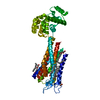

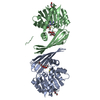
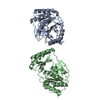




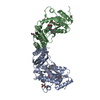
 PDBj
PDBj